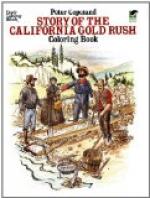“And the bull-fights, Harry? Oh, yes, there was a bull-fight every Sunday afternoon, and everybody went, as you do to the football games. The ladies clapped their hands if the sport was good, or if the bull was killed by the brave swordsman. And if the men got hurt or the horses,—well, we only thought that was part of the game, you see. El toro, as we called the bull, always tried to save himself; and if he was savage and cruel, that was his nature, to try to kill his enemies. The gay dresses and the music was what I cared for, and then all my friends were there, also.
[Illustration: Santa Barbara mission. Founded 1786.]
“But you must be tired of my old stories; is it not so, my children? No, you want to hear about the dances, you say? Well, every party was a dance; a fandango or ball, if it was given in a hall where everybody could come, but at houses where just the people came who were invited we called it only a dance. Every old grandfather or little girl, even, danced all night long, and the rooms were hung with flags and wreaths. All the Spanish dances were pretty, and the ladies with their gay dresses and mantillas, and the gentlemen in velvet suits trimmed with gold, made a fine picture. At the cascarone, or egg-shell dance, baskets of egg-shells filled with cologne or finely cut tinsel or colored papers were brought into the room, and the game was to crush these shells over the dancers’ heads. If your hair got wet with cologne or full of gilt paper, everybody laughed, and you laughed too, for that was the game, you know. Ah, there was plenty of merry-making and feasting in those days, children,” and Senora Sanchez sighed again and went on with her “drawn-work,” while the bell in the old Mission church near by rang five o’clock, and we children ran home talking of those old times before the Gringos came to California.
THE AMERICANS AND THE BEAR-FLAG REPUBLIC
While Spain owned Mexico and the two Californias, the Missions were at their best and grew rich in stores of grain and in cattle and horses. Almost all the people were Spanish or Indians, and they lived at the Missions or in ranches near by. But when Mexico in 1822 refused to be ruled by Spain, Alta or Upper California became a Mexican territory, and, later on, a republic with governors sent from Mexico. The Mission Padres did not like the change, and thought that Spain should still own the New World. Before long it was ordered that the Missions should be turned into pueblos, or towns, and that the Padres were no longer to make slaves of the Indians. The missionaries were to stay as priests, and to teach the Indians in schools, but the Mission lands were to be divided so that each Indian family might have a small farm to cultivate. From that time the Missions began to decay and were finally given up to ruin.




